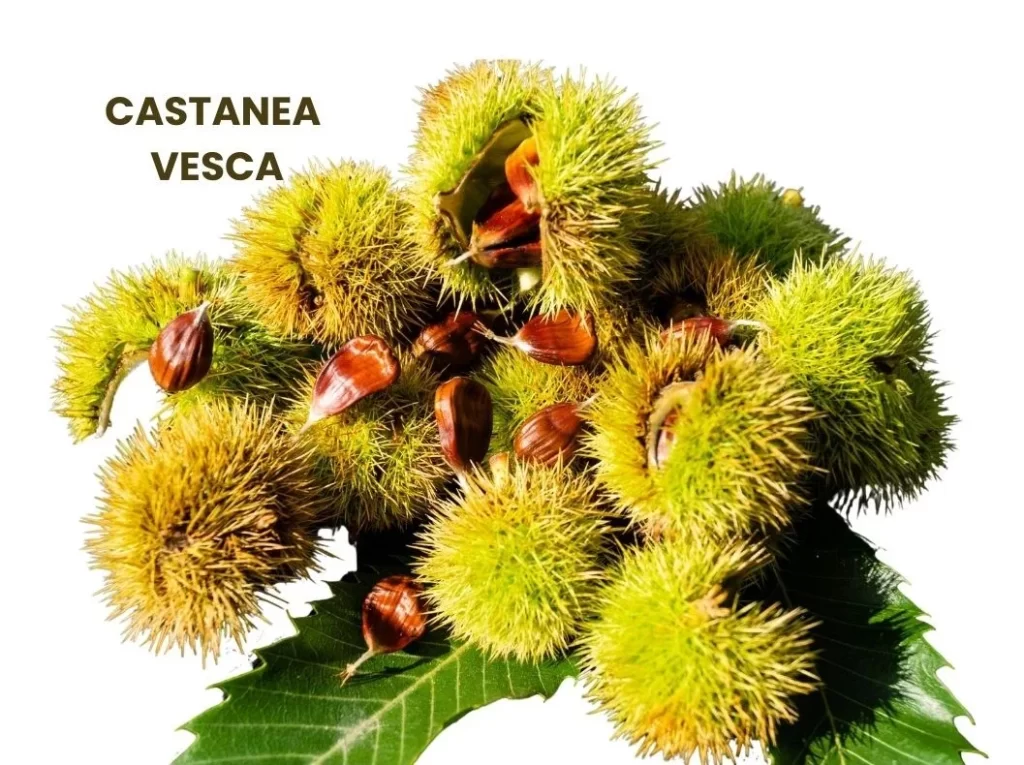Castanea Vesca, derived from chestnut leaves, serves as a beneficial remedy for whooping cough, particularly in its early stages, characterized by a dry, ringing, violent, and spasmodic cough.
It also addresses symptoms like desire for warm drinks, excessive thirst, loss of appetite, diarrhea, and thick urine.
Additionally, it offers relief for conditions such as lumbago and weak back, where the individual struggles to straighten up.

Table of Contents
ToggleSOURCE INFORMATION
Scientific Classification
- Kingdom: Plantae
- Family: Fagaceae
- Genus: Castanea
- Species: Vesca
Origin
- Castanea Vesca, commonly known as European chestnut, originates from regions of Europe and Asia.
- The tree belongs to the Fagaceae family, which includes various species of chestnuts and oaks.
- Chestnut leaves are utilized in homeopathy for their therapeutic properties.
Historical Facts
- Chestnuts have been a staple food source for humans for thousands of years, with evidence of their consumption dating back to ancient civilizations such as the Greeks and Romans.
- In traditional medicine systems, various parts of the chestnut tree, including the leaves, bark, and nuts, have been used to treat a range of ailments.
- The European chestnut (Castanea Vesca) has cultural significance in regions where it grows, often symbolizing longevity, fertility, and abundance.
- European chestnut trees are known for their tall stature and broad canopies, making them valued for their timber as well as their edible nuts.
Therapeutic Reputation
- Chestnut leaves, when prepared as a homeopathic remedy (Castanea Vesca), are renowned for their efficacy in addressing respiratory conditions, particularly whooping cough.
- The remedy is valued for its ability to alleviate symptoms such as dry, spasmodic coughing fits and digestive issues like loss of appetite and diarrhea.
- Castanea Vesca is considered a valuable addition to the homeopathic materia medica for its diverse therapeutic applications.
DRUG PATHOGENESIS
- Castanea Vesca primarily targets the respiratory system, particularly in cases of whooping cough, where it helps alleviate dry, ringing, spasmodic coughing fits.
- It also affects the digestive system, indicated by symptoms like loss of appetite, diarrhea, and thirst.
- Additionally, it provides relief for musculoskeletal issues such as lumbago and weak back.
KEY CHARACTERISTICS
- Effective remedy for whooping cough, especially in the early stage.
- Symptoms include dry, ringing, violent, and spasmodic cough.
- Desire for warm drinks and excessive thirst are prominent.
- Loss of appetite and diarrhea may be present.
- Urine appears thick.
- Provides relief for lumbago and weak back, where straightening up is difficult.
PARTICULAR ORGAN SYMPTOMS
Respiratory System
- Dry, ringing, violent, and spasmodic cough, typical of whooping cough.
Digestive System
- Loss of appetite and diarrhea.
- Excessive thirst and desire for warm drinks.
Urinary System
- Urine appears thick.
MODALITIES
- Symptoms indicating the need for Castanea Vesca may worsen with the consumption of cold drinks or exposure to cold environments.
WHAT ARE MODALITIES IN HOMOEOPATHY?
RELATIONSHIP WITH OTHER DRUGS
- Comparable to Pertussin, especially for whooping cough when symptoms recur after being temporarily alleviated.
- Other remedies to consider include Dros., Mephitis, Naphthal, and Ammon brom.
DOSE
- Administered in tincture form.
Frequently Asked Questions
What conditions does Castanea Vesca address?
- Castanea Vesca is particularly useful for whooping cough, early-stage symptoms characterized by dry, spasmodic coughing fits, as well as digestive issues like loss of appetite and diarrhea.
What are the key symptoms indicating the need for Castanea Vesca?
- Key symptoms include dry, violent coughing fits, excessive thirst, desire for warm drinks, loss of appetite, diarrhea, and thick urine.
Is Castanea Vesca safe for self-administration?
- Castanea Vesca should be used under the guidance of a qualified homeopathic practitioner, especially for chronic or severe conditions.
How does Castanea Vesca compare to Pertussin?
- Castanea Vesca shares similarities with Pertussin, especially in addressing whooping cough.
- However, Castanea Vesca is indicated in the early stages of the condition, while Pertussin may be suitable when symptoms recur after temporary relief.
Meaning of Difficult Words
- Spasmodic: Characterized by sudden, involuntary muscular contractions or convulsive movements.
- Lumbago: Pain in the lower back or lumbar region.
- Alleviate: To make (suffering, deficiency, or a problem) less severe.
- Musculoskeletal: Relating to the muscles and skeleton.
